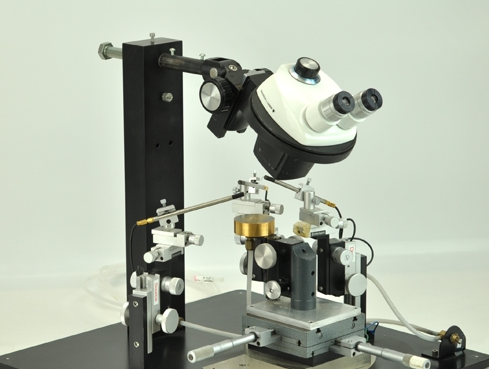Used Custom Probe Station #9004454 for sale
URL successfully copied!
Tap to zoom


ID: 9004454
Probe Station
Steel base plate 20" x 20" x 1/2"
Brinkmann stages used in probe position settings
(3) Probe supports with micrometer adjustment for the X and Y axis
Z axis has course and fine adjustment knobs for height adjustment
(3) Probes with a fine angled tip for electrical contact probing has a shielded coaxial cable connected
Centrally located sample support stage, 4-3/4" x 4-3/4" under a Bausch & Lomb zoom microscope
This stage has a micrometer for the X and Y position adjustment and the ability to be rotated about 45 degrees to the right and left
Bausch & Lomb Stereo Zoom 5: Zoom range: 0.8x to 4.0x
(2) 20x WF eye pieces
Vacuum test plate, no vacuum pump comes with the unit
Plastic vacuum line and a switch for connecting or removing the vaccum is mounted on the base plate
Light source iincluded (no mounting rods).
A Prober, also known as a Custom Probe Station, is a highly advanced technology used for testing and measuring the electrical characteristics of electronic components. A Probe Station typically consists of a vacuum-sealed chamber with multiple probes, each of which can be independently targeted to a specific area of the device under test (DUT). In addition, it usually includes a platform that can be adjusted to accommodate the size, shape, and electrical characteristics of the device. The primary purpose of a Custom Probe Station is to measure and analyze the electrical characteristics of the DUT. This includes measuring the current, voltage, and resistance of the circuit, as well as measuring the temperature and thermal characteristics of the device. The probes, which are generally precision instruments, can also be used to measure other parameters, including signal-to-noise ratio, voltage noise, test speed, power consumption, leakage current, and stability. Probing with the Prober is carried out using a semiconductor prober. This machine can be programmed to probe various areas across the device, providing valuable insight into the performance of the device. For example, probing can be used to investigate the switch closure or opening times, the impedance of the device, and the power losses and dissipations. After probing, images of the DUT can be produced for visual analysis. In addition to probing, a Probe Station can also be used to perform tests such as artificial aging tests, ESD tests, oscilloscope tests, voltage drop tests, current-voltage relationship tests, thermal tests, and optical microscopy. It can also be used to produce graphs to help compare device operation. Furthermore, test results can be saved and uploaded to a database for future analysis. Custom Probe Stations also provide reliable screening and advanced test procedures for customers. For example, tests can be programmed to hunt for anomalies, such as short circuits, across the device. When a faulty component is detected, a Custom test procedure can be designed to identify and qualify the fault, and the component can be replaced. Overall, Custom Probe Stations are exceptionally useful tools for testing and analyzing the electrical characteristics of electronic components in a range of applications. They are highly reliable, accurate, and customizable, and can provide invaluable insight into the performance of a device.
There are no reviews yet